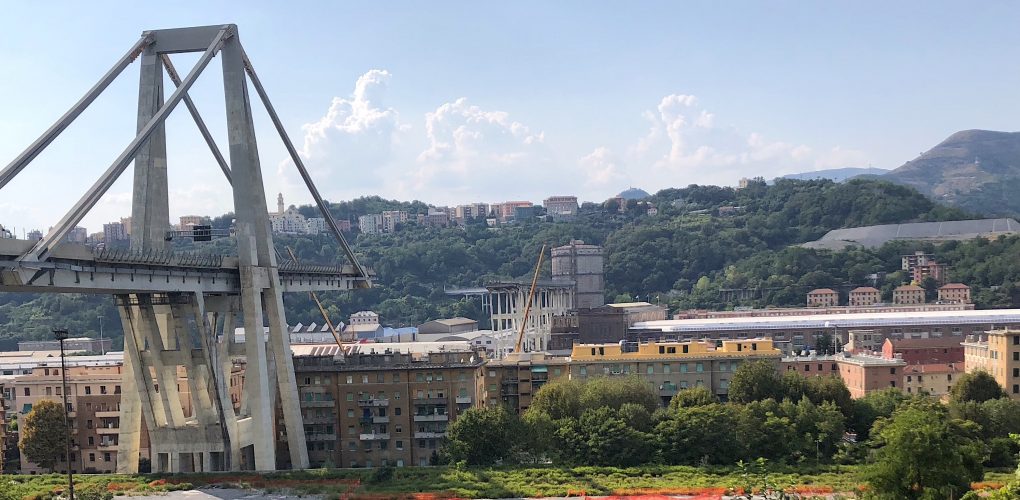Did you know: Last year’s devastating Morandi Bridge disaster, which killed 43 people in Genoa, Italy, is directly connected to a well-known fashion company, one that you’ve probably purchased sweaters from?
For many years prior to the disaster, the company’s association with the bridge was identified as a significant risk to the stability of the structure and the safety of the people who drive over it.
By way of background, the Benettons, the Italian family known for the wool sweaters and other types of clothing sold in its 5,000 stores all over the globe, also controlled Autostrade per l’Italia (Highway for Italy), the organization that managed the Morandi Bridge, along with more than half of Italy’s 4,000 miles of toll roads and bridges.
Initially, the Benetton’s involvement with Autostrade, which began in the late 1990s, was expected to have a positive impact on the family’s fortunes and the Italian economy.
At the time, Benetton started having a difficult time competing against low-cost, fast-fashion retailers, like the Gap, Zara, and H&M. They wanted to diversify into businesses that provided a more dependable income stream. Investing in a government monopoly like toll roads and bridges seemed to fill the bill perfectly.
The move paid off over time for the family. Today, just 5 percent of the Benetton’s $14 billion portfolio comes from selling clothing while 50 percent comes from bridges, toll roads, and other infrastructure.
However, the move may not have paid off for the Italian people.
The Benettons have long been controversial because of the provocative and progressive ads they used to promote their clothing brand. Little did they know that they would become even more notorious for their involvement in Autostrade.
Long before the bridge collapse, an economic professor named Marco Ponti warned that Autostrade was earning excessive profits and that the Italian government was doing too little to oversee and regulate the company and the infrastructure it managed.
All the way back in 2003, Mr. Ponti claimed that Italian taxpayers were being shorn “like flocks of sheep” by the Benettons and Autostrade.
The warnings were ignored, and 15 years later, the Morandi Bridge collapsed. It is currently the subject of a criminal inquiry. More than 20 people are under investigation, including nine who work for Autostrade and three from the Italian Ministry of Infrastructure and Transport.
Investigators are reviewing many years of email exchanges, documents, and phone logs trying to figure out who or what entity is responsible for the tragedy.
While no evidence has been found to date that bridge inspections, or records related to them, were manipulated, there is some suspicion because the parent company of Autostrade also owned the company that conducted inspections and safety checks on the Morandi Bridge.
In addition to this, experts are looking into what went wrong when Italy privatized its roadways. In the process of doing so, many believe Autostrade was allowed to earn extraordinary profits with very little oversight or regulation.
The Benetton’s contract is unusual in that it runs until 2038 and allows Autostrade to increase tolls every year. This is a remarkably long and favorable agreement for the family, which was agreed to by the government because it was desperate to find cash that would allow them to join the eurozone at the time it was signed.
The Morandi Bridge was developed after World War II as a symbol of Italian engineering expertise and style. It was later privatized when the country desperately needed to get out of debt so it could qualify to become a member of the eurozone.
Autostrade has contributed billions of euros to the Italian state, paying nearly 600 million euros a year in corporate taxes, V.A.T., and license fees. The entity provides an indirect way for the government to tax drivers for infrastructure that, when it was privatized, had almost been paid for. In other words, taxpayers are still funding projects that they had paid off.
Many prominent experts in Italy believe the government decided to take a hands-off approach to regulating bridge inspections because of revenue from the tolls that were being collected while traffic was flowing over the bridge.
Closing down the entire Morandi Bridge for significant maintenance — or replacing it, which many experts believed was the logical next step after the lifespan and capabilities of the structure had reached its limits — could have cut off that revenue.
Autostrade has not revealed what led to the collapse, but they have said that they believe they did everything they could to keep the vulnerable structure safe. In the three and a half years prior to the disaster, the company claims to have spent more than $10 million maintaining and repairing the bridge. Road crews worked on it five days a week during that time.
The bridge collapse has become a major political issue in Italy. It’s a key talking point for the Five Star Movement, one of the populist parties that formed a coalition national government prior to the bridge disaster. Five Star has countered Italy’s trend toward privatization. They’re concerned about mutually beneficial deals between the government and private firms and the impact they could have to the people of Italy.
There could be a lesson in all this for people in the United States, where privatizing bridges and roadways is often suggested as a solution to the nation’s infrastructure crisis.
Experts warn against something called regulatory capture, which is what happens when regulators and watchdogs become subservient to the entities they are supposed to supervise. This often happens when infrastructure is privatized and lines become blurred. The welfare and safety of drivers and others is no longer of primary concern.
It could also result in U.S. residents continuing to pay for bridges and other infrastructure for far too long, while structures receive questionable maintenance and service.
The Morandi Bridge collapse is a lesson that Americans should take to heart before making potentially bad decisions about infrastructure during a challenging time, like Italy did almost 30 years ago.

